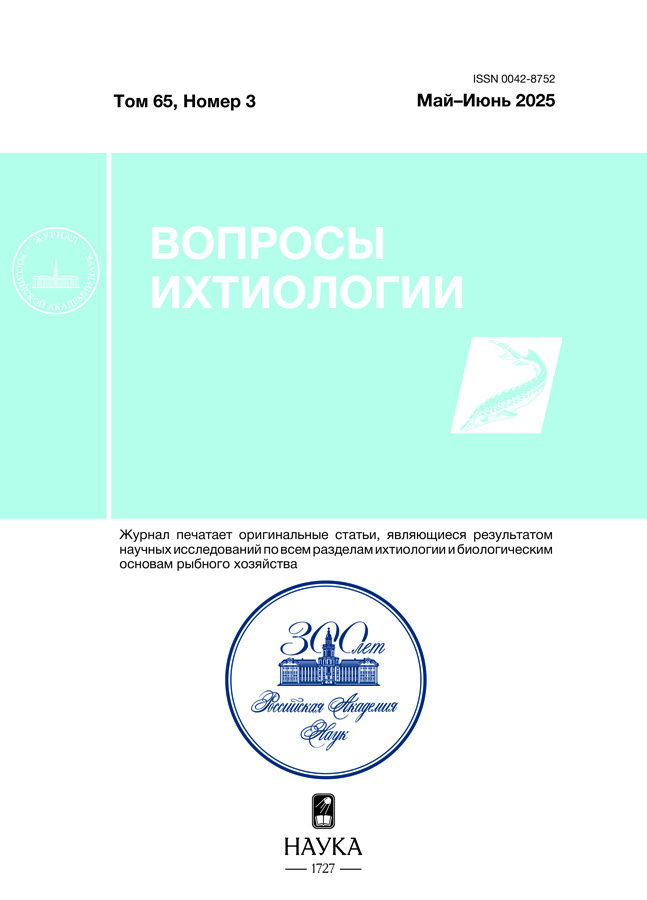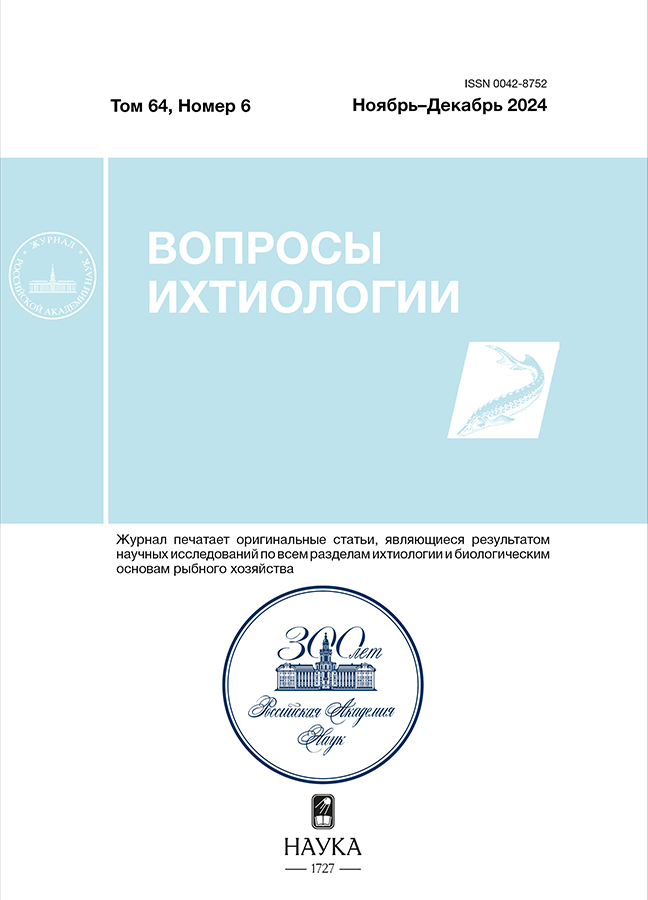Fish distribution in lacustrine and riverine biotopes of bratsk reservoir based on the results of hydroacoustic surveys
- Authors: Gerasimov Y.V.1, Borisenko E.S.2, Pavlov D.D.1, Shlyapkin I.V.1, Tsvetkov А.I.1, Pavlov D.S.2
-
Affiliations:
- Papanin Institute for Biology of Inland Waters, Russian Academy of Sciences
- Severtsov Institute of Ecology and Evolution, Russian Academy of Sciences
- Issue: Vol 64, No 6 (2024)
- Pages: 716-733
- Section: Articles
- URL: https://medjrf.com/0042-8752/article/view/681508
- DOI: https://doi.org/10.31857/S0042875224060065
- EDN: https://elibrary.ru/QSATOI
- ID: 681508
Cite item
Abstract
Fish distribution in different areas of Bratsk Reservoir has been studied using hydroacoustic equipment. The average abundance of fish decreases (r = –0.70; p < 0.05; R2 = 0.49) from the near-dam reach (214 ± 34 ind./ha) to the water area in the upper reaches of the reservoir (113 ± 43 ind./ha). A similar relationship is observed in the dynamics of the abundance of early juveniles and the immature fish population. However, such relationship has not been found in fish with a size of more than 100 mm, which with a low abundance are relatively evenly distributed along the longitudinal axis of the reservoir (10.5 ± 6.6 ind./ha). The common perch (Perca fluviatilis Linnaeus, 1758) is the most abundant species in the reservoir, its highest concentrations are recorded in the lower lacustrine part of the reservoir (139 ± 22 ind./ha). Less abundant cyprinids (Cyprinidae) (41 ± 15 ind./ha) and whitefishes (Salmonidae, Coregoninae) (12 ± 4 ind./ha) are more evenly distributed along the longitudinal axis of the reservoir. Temperature stratification of the water column is an important factor in the ecological differentiation of the fish population in the reservoir. The major part of the ichthyomass consisting of relatively warm-water fish species from the families Percidae and Cyprinidae (common roach (Rutilus rutilus (Linnaeus, 1758) and common bream (Abramis brama (Linnaeus, 1758)) is concentrated in the warming up epilimnion. The fish population in the cold hypolimnion consists of single individuals of the Baikal omul (Coregonus autumnalis Pallas, 1776) and peled (C. peled (Gmelin, 1788)). Transverse distribution of fish depends on the presence of a runoff flow. At relatively high flow rates, fish begin to avoid the midstream part in the studied sites of the reservoir and concentrate in the floodplain areas (R2 = 0.54; p < 0.0001).
Full Text
About the authors
Yu. V. Gerasimov
Papanin Institute for Biology of Inland Waters, Russian Academy of Sciences
Author for correspondence.
Email: gu@ibiw.ru
Russian Federation, Borok, Yaroslavl oblast
E. S. Borisenko
Severtsov Institute of Ecology and Evolution, Russian Academy of Sciences
Email: gu@ibiw.ru
Russian Federation, Moscow
D. D. Pavlov
Papanin Institute for Biology of Inland Waters, Russian Academy of Sciences
Email: gu@ibiw.ru
Russian Federation, Borok, Yaroslavl oblast
I. V. Shlyapkin
Papanin Institute for Biology of Inland Waters, Russian Academy of Sciences
Email: gu@ibiw.ru
Russian Federation, Borok, Yaroslavl oblast
А. I. Tsvetkov
Papanin Institute for Biology of Inland Waters, Russian Academy of Sciences
Email: gu@ibiw.ru
Russian Federation, Borok, Yaroslavl oblast
D. S. Pavlov
Severtsov Institute of Ecology and Evolution, Russian Academy of Sciences
Email: gu@ibiw.ru
Russian Federation, Moscow
References
- Борисенко Э.С., Мочек А.Д., Павлов Д.С. 2011. Гидроакустический метод исследования рыбных ресурсов внутренних водоемов // Матер. докл. I Всерос. конф. с междунар. участием “Современное состояние биоресурсов внутренних водоемов”. Т. 1. М.: Акварос. С. 74–85.
- Егоров А.Г. 1959. Перспективы рыбохозяйственного освоения ангарских водохранилищ. Иркутск: Иркут. кн. изд-во, 47 с.
- Государственный водный кадастр. 1985. Разд. 1. Поверхностные воды. Сер. 2. Ежегодные данные. Ежегодные данные о режиме и ресурсах поверхностных вод суши. 1983. Ч. 2. Озера и водохранилища. Т. 1. РСФСР. Вып. 13, 14. Бассейн Ангары и озера Байкал. Иркутск: Иркут. УГКС, 133 с.
- Государственный водный кадастр. 1987. Разд. 1. Поверхностные воды. Сер. 2. Ежегодные данные. Ежегодные данные о режиме и ресурсах поверхностных вод суши. 1985. Ч. 2. Озера и водохранилища. Т. 1. РСФСР. Вып. 13, 14. Бассейн Ангары и озера Байкал. Обнинск: Изд-во ВНИИГМИ-МЦД, 139 с.
- Государственный водный кадастр. 1989. Разд. 1. Поверхностные воды. Сер. 2. Ежегодные данные. Ежегодные данные о режиме и ресурсах поверхностных вод суши. 1987. Ч. 2. Озера и водохранилища. Т. 1. РСФСР. Вып. 13, 14. Бассейн Ангары и озера Байкал. Обнинск: Изд-во ВНИИГМИ-МЦД, 104 с.
- Государственный водный кадастр. 1990. Разд. 1. Поверхностные воды. Сер. 2. Ежегодные данные. Ежегодные данные о режиме и ресурсах поверхностных вод суши. 1988. Ч. 2. Озера и водохранилища. Т. 1. РСФСР. Вып. 13, 14. Бассейн Ангары и озера Байкал. Обнинск: Изд-во ВНИИГМИ-МЦД, 98 с.
- Кудрявцев В.И., Дегтев А.И., Борисенко Э.С., Мочек А.Д. 2006. Опыт использования гидроакустического метода и аппаратуры количественной оценки водных биомасс на внутренних водоемах // Рыб. хоз-во. № 5. С. 69–71
- Купчинская Е.С., Купчинский А.Б. 1996. Влияние антропогенных факторов на состояние ихтиофауны водохранилищ Ангары // Матер. конф. по изучению водоемов “Задачи и проблемы развития рыбного хозяйства на внутренних водоемах Сибири”. Томск: Изд-во ТГУ. С. 24−25.
- Купчинский А.Б., Купчинская Е.С. 2006. Состояние ихтиофауны водохранилищ Ангары // Бюл. ВСНЦ СО РАМН. № 2 (48). С. 56–61.
- Мамонтов А.М. 1977. Рыбы Братского водохранилища. Новосибирск: Наука, 246 с.
- Мамонтов А.М. 2005. Рыбохозяйственное значение и особенности формирования ихтиофауны Байкало-Ангарских водохранилищ // Матер. Всерос. науч.-практ. конф. (Дружининские чтения) “Научные основы экологического мониторинга водохранилищ”. Хабаровск: Изд-во ИВЭП ДВО РАН. С. 141–144.
- Матвеев А.Н., Самусёнок В.П. 2009. Круглоротые (Cyclostomata) и рыбы (Pisces) водоёмов бассейна реки Ангары // Аннотированный список фауны озера Байкал и его водосборного бассейна в 2 т. Т. 2. Водоёмы и водотоки юга Восточной Сибири и Северной Монголии. Кн. 1. Новосибирск: Наука. С. 396–416.
- Матвеев А.Н., Самусенок В.П., Вокин А.И. и др. 2012. Промысловые виды рыб водоемов Иркутской области // Байкал. зоол. журн. № 2 (10). С. 16–29.
- Обзор состояния и загрязнения окружающей среды в Российской Федерации за 2022 год. 2023. М.: Росгидромет, 219 с.
- Олифер С.А. 1977. Рыбохозяйственное освоение Усть-Илимского водохранилища // Изв. ГосНИОРХ. Т. 115. С. 65–95.
- Павлов Д.С., Лупандин А.И., Костин В.В. 2007. Механизмы покатной миграции молоди речных рыб. М.: Наука, 213 с.
- Павлов Д.С., Борисенко Э.С., Мочек А.Д., Дегтев А.И. 2008. Исследования распределения рыб в реках с помощью гидроакустических комплексов // Матер. II Междунар. науч.-практ. конф. “Повышение эффективности использования водных биологических ресурсов”. М.: Изд-во ВНИРО. С. 25–28.
- Понкратов С.Ф. 1981. Формирование запасов основных промысловых рыб Усть-Илимского водохранилища // Тр. ГосНИОРХ. № 165. С. 102–109.
- Понкратов С.Ф. 2013. Инвазии чужеродных видов рыб в бассейн Ангарских водохранилищ // Рос. журн. биол. инвазий. № 4. С. 59–69.
- Понкратов С.Ф., Панасенков Ю.В. 2008. Акклиматизация и воспроизводство ценных видов рыб в ангарских водохранилищах. Иркутск: Изд-во ИГУ, 139 с.
- Попов П.А. 2010. Формирование ихтиоценозов и экология промысловых рыб водохранилищ Сибири. Новосибирск: Гео, 216 с.
- Пушкина Р.Г., Олифер С.А. 1980. Формирование ихтиофауны в Братском водохранилище // Рыбы и рыбное хозяйство Восточной Сибири. Улан-Удэ: Бурят. кн. изд-во. С. 158–165.
- Романовский Ю.Э., Смуров А.В. 1975. Методика исследования пространственного распределения организмов // Журн. общ. биологии. Т. 36. № 2. С. 227–236.
- Тугарина П.Я., Храмцова В.С. 1996. Рыбохозяйственная перспектива использования омуля в Братском водохранилище // Ихтиологические исследования озера Байкал и водоемов его бассейна в конце ХХ столетия. Иркутск: Изд-во ИГУ. С. 29−33.
- Юрьев А.Л., Пастухов М.В., Перминова С.А. и др. 2010. Биологическая характеристика окуневых рыб верхнего участка Братского водохранилища в современный период // Изв. ИГУ. Сер. Биология. Экология Т. 3. № 3. С. 52–61.
- Borisenko E.S., Gusar A.G., Goncharov S.M. 1989. The target strength dependence of some freshwater species on their length-weight characteristics // Proc. Inst. Acoust. V. 11. Pt. 3. Р. 27–34.
- Borisenko E.S., Degtev A.I., Mochek A.D., Pavlov D.S. 2006. Hydroacoustic characteristics of mass fishes of Ob-Irtysh basin // J. Ichthyol. V. 46. Suppl. 2. Р. S227–S234. https://doi.org/10.1134/S0032945206110130
- Kubecka J., Duncan A. 1998. Acoustic size vs. real size relationships for common species of riverine fish // Fish. Res. V. 35. № 1–2. Р. 115–125. https://doi.org/10.1016/S0165-7836(98)00066-6
Supplementary files


















